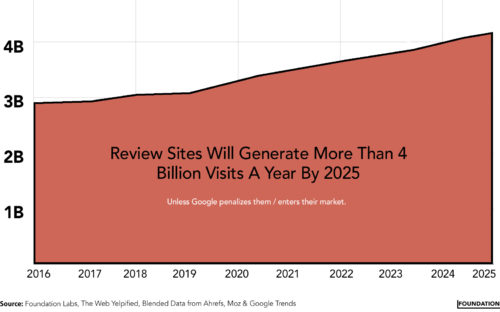Article's Content
Let’s take a quick trip down memory lane.
Late in 2012, Stewart Butterfield and his team rolled up their sleeves and swung into action to “make work-life simpler, more pleasant and more productive.”
The result was the collaboration software—Slack.
Within 24 hours of their beta launch in 2013, Slack recorded 8k new users and grew to 50k within a few weeks. That’s massive.
Fast forward a few years, the results have been nothing short of impressive. Slack earned a massive $7B valuation before going public in 2018.
The collaboration hub has achieved even greater heights since then. Here’s what Slack’s scorecard looks like:


Additionally, they have some impressive accolades:
- 65 of the Fortune 100 use Slack
- 150+ countries have daily active users in Slack
- Named the fastest-growing tech company
The company’s legendary success begs the question, “How did Slack become a viral success in less than ten years?”
Sure, many factors contributed to Slack’s viral growth. However, we do know that Slack didn’t hire an outbound sales team until 2016, and they reached a $1.1B valuation before bringing a CMO onboard.
Lead generation, lead nurturing campaigns, thought leadership, SEO, and other marketing strategies weren’t part of their initial marketing arsenal. Yet, Slack’s value grew from 0 to nearly $4B in less than four years.
How did the collaboration hub achieve its early successes?
Slack’s Non-Traditional Growth Formula: From 0 to 10M+ Users
Slack’s initial growth formula is pretty straightforward. They:
- “Cajoled” Their Friends
- Built a Word-of-Mouth Engine
- Created a Killer Freemium Product
- Built in a Real Viral Loop
- Created An “Enemy”
- Responded To ALL Feedback
Let’s see how Slack used each component, and how you can use them to drive growth for your SaaS product.
1. Slack “Cajoled” Friends to Try It
Yep! You heard right.
Slack asked their friends to be the first beta testers and try out their app (which is something software testing companies can also do).
A few months before the preview release in August 2013, Butterfield and his team “cajoled” friends at other companies to try out the product and leave feedback.
The goal was to generate awareness, measure product-market fit, and gather enough feedback to identify and resolve issues before Slack’s official launch. Companies like Rdio, TGC, Medium, and Cozy were amongst the first beta users.
Slack’s cajoling tactic worked well.
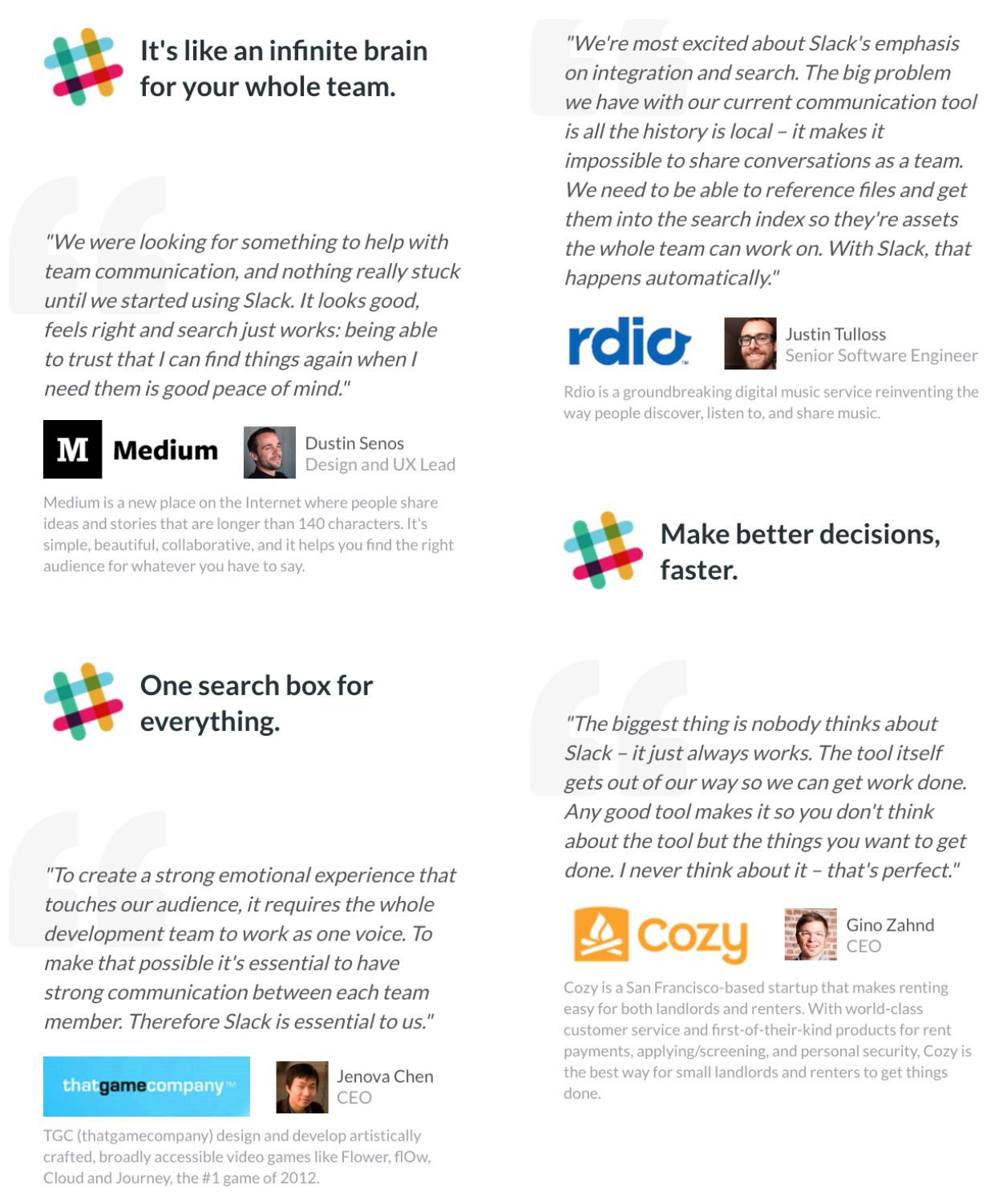

The companies who participated in their beta tests left feedback that Slack turned into a “charger” for prospects’ trust batteries. Some beta users went as far as putting their love on display for Twitter users to see:


It’s such a joy to see customers so deeply in love with your solution from the get-go that they “shout it from the rooftops”, and inspire others to choose your product.
That’s pretty much every founder’s dream: to find product-market fit as quickly as possible. For Slack, it was almost instantaneous. At every stage, Slack was met with acceptance and love from its users.
Sure, it took a ton of iteration and effort from everyone on the team. However, Butterfield and his team eventually built something the workforce loved.
The key takeaway for SaaS brands is this:
Reach out to those closest to you before releasing your product to the rest of the world. If you can convince them to try your product, you’ll be amazed at how quickly the word about your product will spread, especially if they love your product!
Also, asking them to leave feedback is a way of gathering real customer insights to improve your product. It is also a brilliant strategy for generating social proof.
People trust and connect with relatable stories more than they trust ads. With social proof, you can help prospects understand technical terminologies and processes that reflect your unique value proposition like ShipBob did.
2. Slack Built a Word-Of-Mouth Engine
Slack credits most of its initial growth to word-of-mouth marketing. This tweet shows how word of mouth drove Slack’s growth in the first six months:
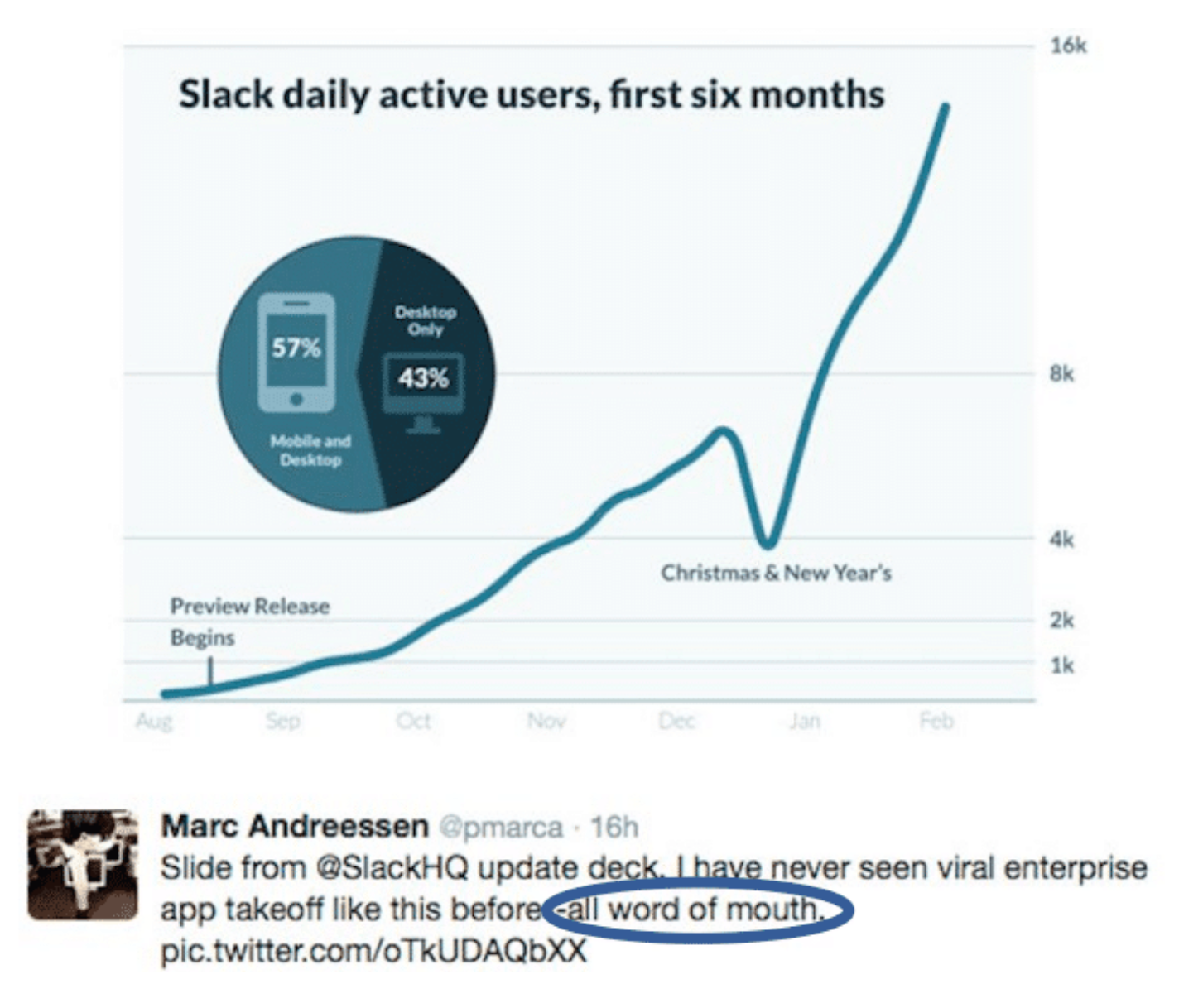

[Source]
Slack became the fastest-growing business app of all time by relying on word-of-mouth.
Yes, word-of-mouth marketing. Here’s exactly how they pulled it off:
In August 2013, the company gave people a chance to request invitations to try out their preview release:


Notice that the beta version was called a “preview release,” not a beta version.
According to Butterfield, people usually perceived beta as unreliable or flaky. So, the team chose a word that would get people curious and excited enough to sign up.
The approach worked like magic.
8k people signed up in 24 hours. Two weeks later, Slack users grew to 15k. By the time they launched publicly a year later, they had 285k Daily Active Users (DAUs), and they hit 1M+ DAUs the next year.
To date, Slack still prioritizes Word-of-Mouth Marketing as a go-to marketing strategy.
Sure, Butterfield had some leverage in the beginning, which most brands can’t count on. He was already recognized as the founder of the photo-sharing platform, Flickr.
Even if you don’t have his kind of leverage, Slack’s word-of-mouth strategy is replicable. We’ll show you how they pulled it off with a combination of elements.
What is Word of Mouth Marketing?
Word Of Mouth Marketing (WOMM) is a timeless, free form of marketing, triggered by a customer’s experience with your product. The goal of WOMM is to build awareness and ignite initial trust in the hearts of prospects, using the people closest to them.
- A whopping 92% of people around the world say they trust recommendations from friends and family above all other forms of advertising (Nielsen).
- Beyond friends and family, 88% of people trust online reviews written by other consumers as much as they trust recommendations from personal contacts (Bright Local).
- 74% of consumers identify word of mouth as a key influencer in their purchasing decisions (Ad Week).
The more you delight your customers, the more likely they are to make a recommendation, with or without a nudge, and the greater your chances are of generating more users and revenue. The opposite happens when an unhappy customer spreads the word about your product.
That’s the power of word of mouth.
3. Slack Was Actually Free
Slack created a cool product, but they didn’t stop there. They created a cool product that was also free for everyone, like really free.
The company didn’t offer a gated free trial that asked customers for their credit card information. Instead, they earned users’ trust by offering a free version so teams could enjoy the product.


They built something consumers in the workplace craved: a free way to collaborate without any blockers or silos. Slack made a tool that was both useful and free, livening up the workplace and keeping everyone aligned and on track.
In other words, Slack showed its users immediate value with the freemium model. Pricing only entered the picture when its users decided that they needed an upgrade to unlock more features like additional storage or integrations.
Theo Miller from Sitepoint, one of the beta users, described Slack this way:
“Most apps don’t bring me joy. Slack does. It’s so much more than just a messaging app. The attention to detail, the playful vibe, and the robust features set all amount to an unparalleled user experience.”
Apart from having a great product, Slack also did one thing a few SaaS companies got right back in the day: prioritizing Product Qualified Leads (PQLs) over Marketing Qualified Leads (MQLs).
Wes Bush, the founder of ProductLed, defines a PQL as a lead who has experienced meaningful value using your product through a free trial or freemium model.
This strategy worked well for Slack. Instead of relying on lead gen techniques, PQLs engage directly with your product. This is why they are critical to the success of any SaaS brand.
Don’t get us wrong.
Lead generation is still a great marketing tactic. However, PQLs give valuable feedback that you can use to boost product experience
With their feedback, you can learn the joys and frustrations users experience while using your product, and how you can improve their experience.
You also stand a better chance of converting PQLs to paid users than you do MQLs
It’s impossible to accurately gauge the buying intent of someone who joined your mailing list after downloading a resource or signing up for a webinar. On the other hand, having someone sign up for your product indicates that they have a problem your product can solve.
So, how can you replicate this product-led growth strategy for your SaaS product?
First, use a freemium or a free trial plan to capture your audience’s attention and earn initial trust. Give prospects a chance to experience your product before they choose to commit.
Slack’s freemium model allows users to explore their options before making a buying decision. Users shouldn’t have to input their card details before experiencing your product. You risk losing them to the competition. A free plan will drive more users to try your product.
Next, define your PQL.
You might start out defining your PQL as someone who “activated a free or trial account” or “logged in at least five times.”
To make identifying your PQL easier, you can create detailed customer personas to help guide your content marketing campaigns.
Your PQL should have qualities that revolve around your unique value proposition/key activities within your product. That way, you can tell which users have an active interest in your product and are more likely to pay. So, embrace experimentation.
For instance, Slack’s value proposition includes team collaboration, unlimited search, and unlimited integrations. So, their PQL could be someone who has sent 2000 messages or someone who has integrated at least five applications.
But Slack’s PQLs and freemium pricing model is only a fraction of Slack’s viral success.
4. Slack Built in a Viral Loop, from the Beginning
Like Calendly, Slack built virality into their product. This is one of Slack’s major strengths. It allows users to share the product with their network on a grand scale.
See how Justin Scott of the Growth Devil blog defines viral loops:
“The steps a user goes through between entering and inviting more users to the site is called a “viral loop,” and this is the form of marketing that is responsible for businesses going from zero to million-dollar profit margins in a matter of weeks.”
A viral loop works like this:


[Source]
Say that Sandra, Head of Growth, becomes aware of Slack through an ad, a social post, or a friend. Then she downloads Slack, activates the product, and asks her ten teammates to do the same so they can collaborate on a project.
The incentive here is seamless collaboration, alignment, and transparency.
As new users come on board, they can easily collaborate and track their online activity within the organization.
They can share files easily, collaborating with each other on the platform using third-party applications such as Google Drive and Trello.
Suppose one person within an organization recommends the product to someone from a different organization. If that person signs up and loves the experience, they can adopt Slack as a primary communication channel for all teams within their organization. So, the company gains many new users without having to do anything more than keeping the product visible and valuable.
How can you build virality into your product?
The best place to begin is with your customers. Begin by asking questions to understand why people convert. What makes prospects decide to become a user? What makes them convert to paying customers?
Try to see things from the user’s perspective so you can build and ship products that users find valuable. You can use a product research tool like Sprig to gather real-time customer insights regularly.
You can also update your product offering in a way that motivates users to invite other people to join them. For instance, you can offer them an irresistible incentive like Airbnb’s referral loop. When users receive a reward for this effort, they are inspired to do more, and the viral loop accelerates.
While adopting this strategy, focus on your product’s core offering and the value it offers to customers. That way, you can choose a strategy that aligns with your value. proposition. That’s your greatest asset.
5. Slack Created An Enemy: Email
Slack prioritized generating awareness by using audacious, compelling ads.
The hook was: Slack is out to “kill email.” Emails made it difficult for people to keep track of conversations, making collaborations more difficult.
Slack decided to use this weakness as a hook to capture people’s attention and give them a reason why Slack is worth trying.
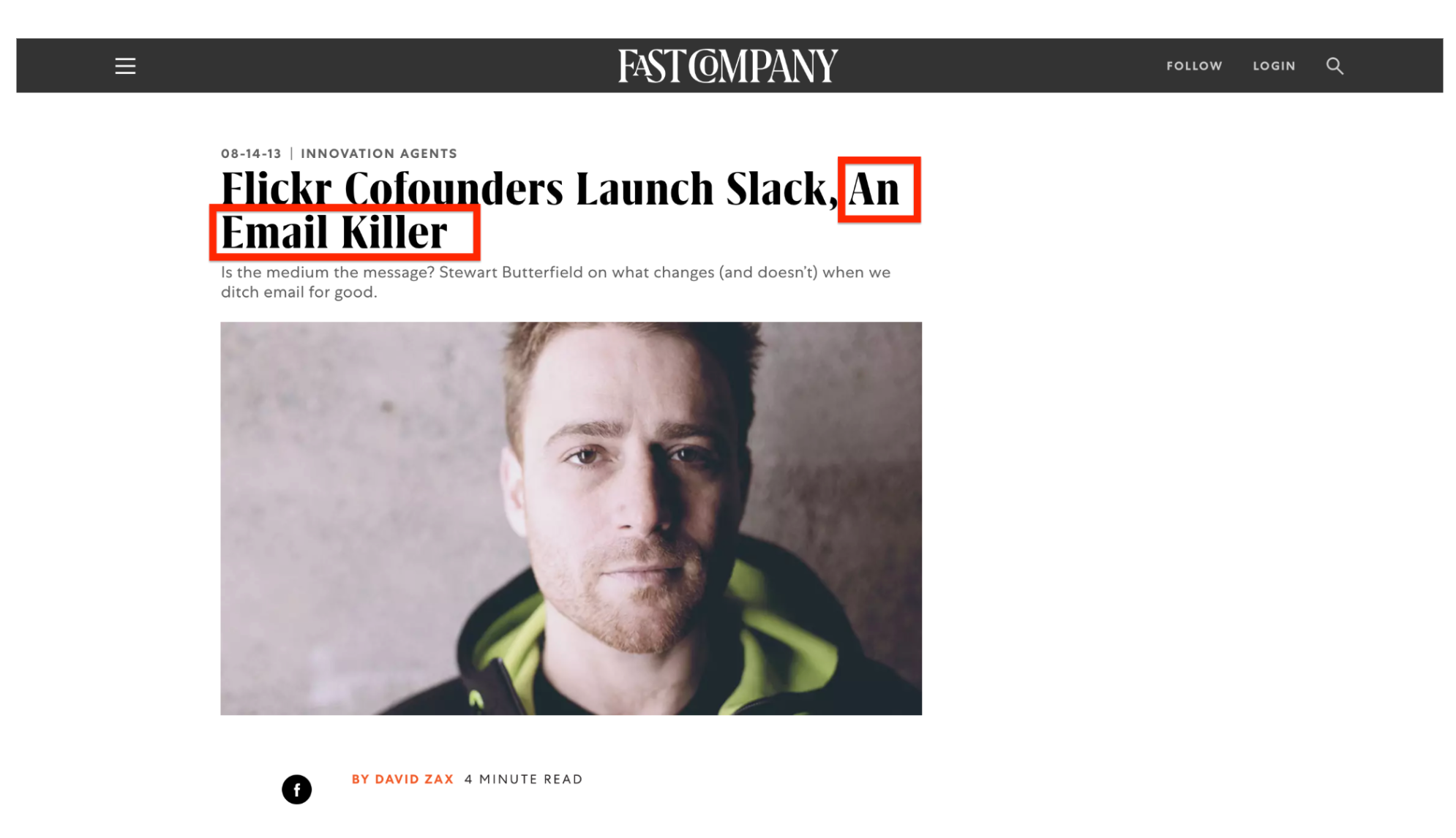

[Source: Fast Company]
They also leveraged Butterfield’s fame to capture and influence people’s perceptions. Look at the titles of some articles that were written about Slack pre-launch:
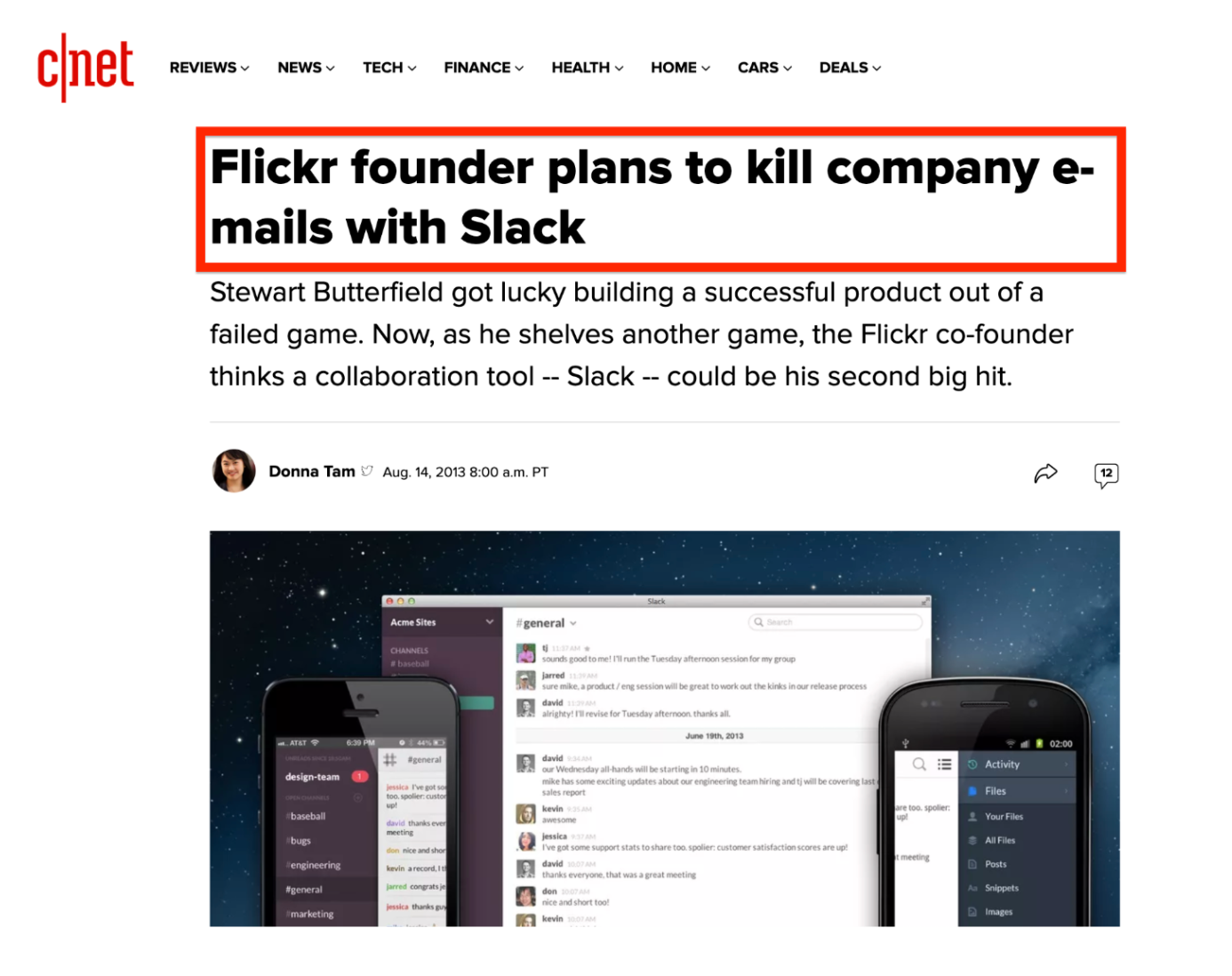

[Source: CNET]
Or this one by Business Insider:
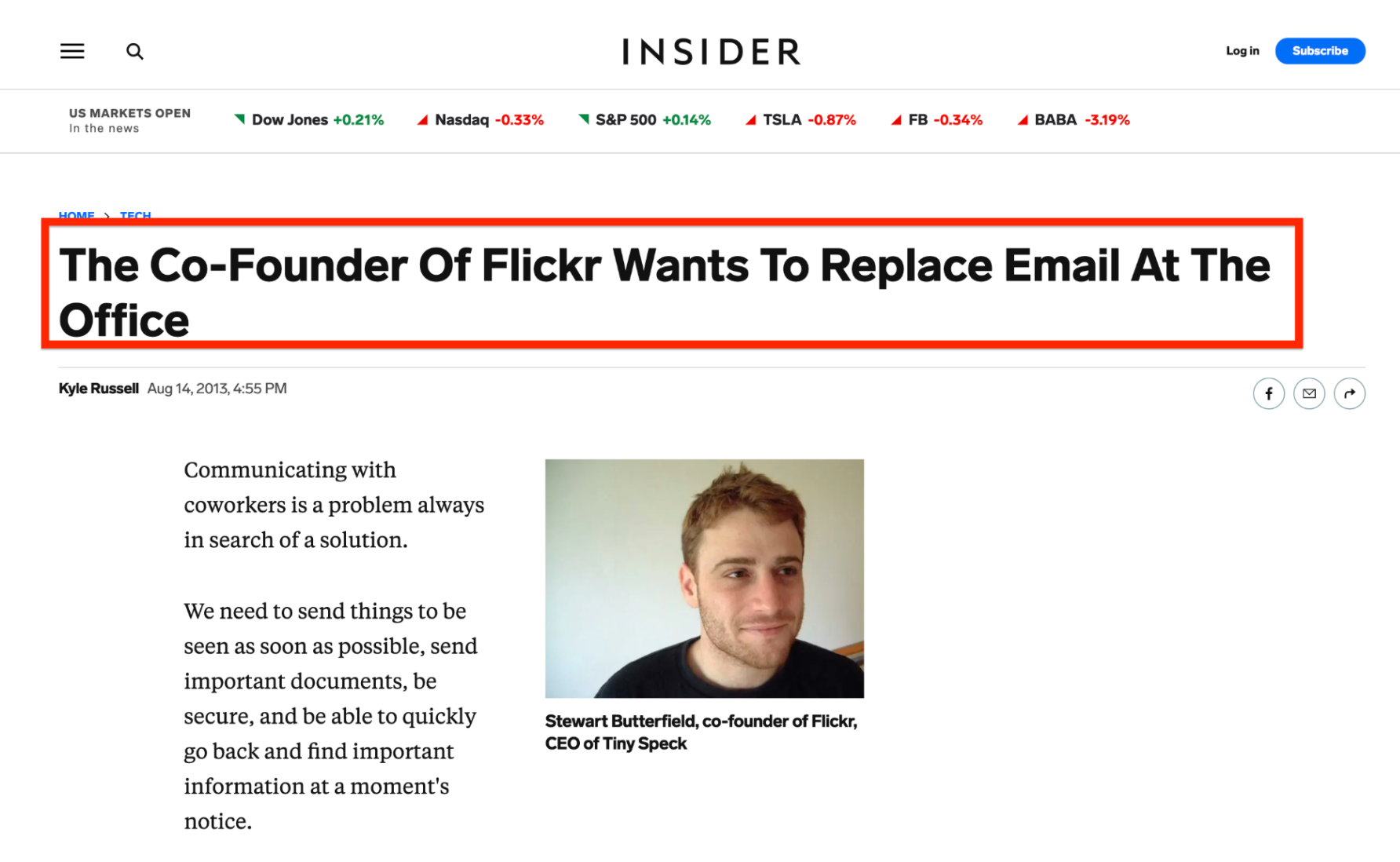

[Source: Business Insider]
As you can see, all of these articles feature the “email killer” mantra that defined early-Slack. It was a brilliant move, we admit.
The power of word of mouth comes back into play here as well. It’s really easy to tell someone to check out Slack because it is an “email killer.” People understand exactly what it does and likely want to replace their email workflow with a better solution.
Even if you’re not a famous founder yet, you can adopt a compelling hook strategy or Salesforce aggressive marketing tactics in the early days. Then use the media to get your message across to your target audience, and keep distributing those ads.
You can invite friends and people in your network to reshare and promote across social media, Facebook groups, community forums, and many other places.
You can check out our content distribution checklist to ensure you’re leveraging all the right channels to spread your content.
6. Slack Responded To EVERY User
Over and over again, we have mentioned how Slack asked its users for feedback directly from the get-go. But this takes it a step further.
In an exclusive interview hosted by First Round, Butterfield revealed that his team ensured that users could respond to every email they received. They approached every help ticket as an opportunity to establish loyalty and improve the product. They also iterated Slack based on requests and suggestions from users.
Rdio, for instance, was one of Slack’s biggest beta-test companies.
The initial Slack version was built to allow smaller teams to collaborate easily. However, with a company with Rdio’s workforce, it was tough for employees, especially new hires, to know which channels to join.
Based on Rdio’s feedback, Butterfield and his team added fields for a description and the number of people using a specific channel. That was a game-changer for Slack in terms of bigger companies.
They asked questions, listened, and iterated. As a result, other companies with more users didn’t have to go through the same fate Rdio would have suffered.
Slack also has a function in the app that lets users send feedback:
They also have a help bot for assistance:
The Slack team also has a dedicated Twitter account for reporting incidents:
Overall, Slack made a conscious effort to connect with their users and show them that they are dedicated to helping them achieve their collaboration goals, personally and through their product.
How can you replicate this strategy?
You can provide active support on your website using software like Drift.
You can also keep several eyes and ears out to monitor everyone talking about your brand online—the good, the bad, and the ugly.
There is so much you can learn from disgruntled customers as well as the happy ones. You can use relevant insights to improve your product or business as a whole. To keep track of these comments, you can use a tool like Mention.
Wrap Up
For Slack, the little things mattered from the beginning.
In addition to a great freemium product, the company used word-of-mouth marketing—organic and paid–to inspire trust, establish credibility, and win customers over. Their customer-centric support culture fostered customer loyalty.
It’s little wonder that Slack’s DAUs are 10M+ strong and counting. Salesforce also saw their value and decided to win them over with a $27.7B deal.
You can also achieve similar results for your SaaS product by paying attention to the little things. Listen to customers. Filter and act on relevant feedback. Build a great freemium product. Be there to answer questions users might have or assist in any way. You’ll see the results start to trickle in, in no distant time.
Stay up to date with all of our latest findings by subscribing to our newsletter today. Signing up also gives you early access to Ross’ Tuesday essay full of exclusive industry insights.
Quick, do it now before the next drop!







